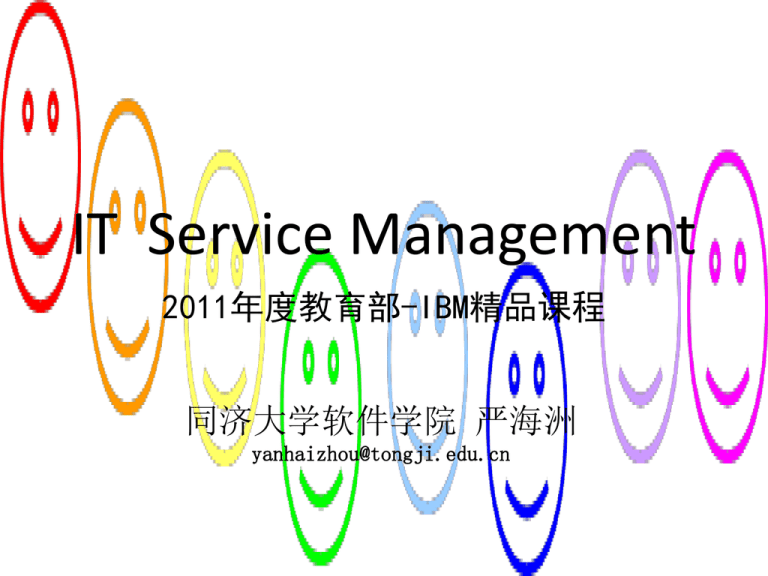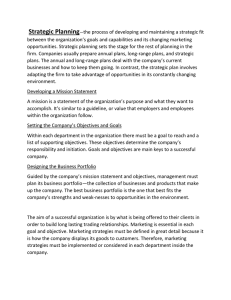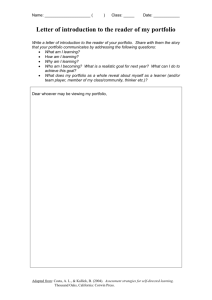IT Service Management 2011年度教育部
advertisement

IT Service Management 2011年度教育部-IBM精品课程 同济大学软件学院 严海洲 yanhaizhou@tongji.edu.cn Chapter 2 Service Strategy Tivoli Software 服务战略 • 服务战略面向CIO •服务战略作为框架的核心,它告诉我们在思考如何做之前,先想想为什么要 做。它为其它模块指明了方向,从而使服务生命周期的所有阶段都强调业务的 重要性。 •《服务战略》介绍了如下的主题和流程: Service Strategy ITIL • Service Management Life Cycle • Service Strategy Processes Strategy Generation IT Financial Management Service Portfolio Management Demand Management • Organizational Development & Design • Implementing Service Strategy 2.1 Introduction Service Strategy 5 The Service Strategy volume provides guidance on how to design, develop, and implement service management not only as an organizational capability but also as a strategic asset. Goals of Service Stratege • • • • • • • • • • 6 What services should we offer and to whom? How do we differentiate ourselves from competing alternatives? How do we truly create value for our customers? How do we capture value for our stakeholders? How can we make a case for strategic investments? How can Financial Management provide visibility and control over value creation? How should we define service quality? How do we choose between different paths for improving service quality? How do we efficiently allocate resources across a portfolio of services? How do we resolve conflicting demands for shared resources? Service Strategy Goals • To understand what services should be offered to support the organisation. • To begin setting policies and objectives for the provision of services in support of the business areas. • To understand how to create value for an organisation. • To offer advice on strategic investments, and • To understand how to define service quality. 7 Value to business Organizations already practicing ITIL may use this publication to guide a strategic review of their ITILbased service management capabilities and to improve the alignment between those capabilities and their business strategies. This volume of ITIL encourages readers to stop and think about why something is to be done before thinking of how. Answers to the first type of questions are closer to the customer’s business. Service Strategy expands the scope of the ITIL framework beyond the traditional audience of IT Service Management professionals. 8 Outcome 9 Constraint 1 0 Service Value • Service value: --Defined by customer’s business outcomes --Dependent on customer’s perceptions • Customer perceptions are influenced by: --Attributes of a service that are indications of value --Present or prior experiences with similar attributes --Relative endowment of competitors and other peers --Customer’s self-image or actual market position (e.g. being an innovator, market leader, and risk-taker) Definition and differentiation of service value is in the customer’s mind 11 Four points of service strategy • • • • 12 Perspective Position Plan Pattern Logic of value creation through services • Utility • Warranty • Utility is what the customer gets, and warranty is how it is delivered. • Customers cannot benefit from something that is fit for purpose but not fit for use, and vice versa. It is useful to separate the logic of utility from the logic of warranty for the purpose of design, development and improvement. 13 2.2 Service strategy principles Utility and Warranty • Utility and Warranty define services and work together to create value for the customer • Utility= 功用 – What does the service do? – Functional requirements – Features, inputs, outputs… – “fit for purpose” • Warranty=功效 – How well does the service do it? – Non-functional requirements – Capacity, performance, availability… – “fit for use” 15 Utility, Warranty, Market Space • A service is a means of delivering value to customers by facilitating outcomes customers want to achieve without the ownership of specific costs and risks. Utility: ‘What the Customer gets’ + Warranty: ‘How is it delivered’ Utility is measured on the basis of the number of key ‘outcomes Warranty is measured in terms of the levels of Availability, Capacity, supported’ and ‘constraints removed’ Continuity and Security = Value Creation The basis of differentiation in the Market Space Market Space – A market space is defined by a set of business outcomes, which can be facilitated by a service. – Market spaces defined in terms of outcomes desired by customers. 16 Combined effect of utility and warranty 17 Service Owner • The Service Owner is responsible to the Customer for a particular service – Initiation and transition – Ongoing maintenance and support – Monitoring and reporting – Identifying improvement opportunities – Prime customer contact 18 Service Provider An organization supplying services to one or more internal customers or external customers • Type 1 – Internal – Embedded in the business unit it serves • Type 2 – Shared – Provide services to multiple business units • Type 3 – External – Provide services to many customers 19 Suppliers and Contracts • Supplier – A third party responsible for supplying goods or services – These are required by the service provider to enable them to deliver services • Contract – A legally binding agreement between two or more parties to supply goods or services 20 RACI Model • A RACI model can be used to help define roles and responsibilities • It identifies the activities that must be performed alongside the various individuals and roles involved • RACI is an acronym for the four main roles of: – R = Responsible — The person or people responsible for getting the job done – A = Accountable — Only one person can be accountable for each task – C = Consulted — The people who are consulted and whose opinions are sought – I = Informed — The people who are kept up-to-date on progress 21 Example RACI Model Director Service Level Problem Service Manager Manager Management Activity 1 AR C I Security Manager Procurement Manager I C Activity 2 A R C C C Activity 3 I A R I C Activity 4 I A R I Activity 5 I I A C 22 I Expansion of RACI Model • A RACI model can be expand to RASCI model: S = Supportive – The people who can support for a task. 23 2.3 Service strategy Strategy Generation Process • Define the market – Understand the customer and opportunities, classify and visualize services –how they create value and in what context – Evaluate the services you could potentially offer, and who you may be able to offer them to! • Develop the offerings – define the market space and define the services based on what is valuable to the customer – Continue to formulate the services you think it will be worthwhile pursuing – Utility and Warranty are considered at this stage 25 ITIL V3 Foundation Course Ver.1.1 Strategy Generation Process (Cont.) • Develop strategic assets – increase the service and performance potential of the organization, treat IT service management as a strategic asset – Look for opportunities to exploit your services and capabilities (to allow more services to more customers) – Develop Service Management so that it becomes a strategic asset • Prepare for execution – do a strategic assessment to find what core differentiations already exist – Take all the necessary steps to ensure that we are ready to go ahead and it is worthwhile doing so 26 ITIL V3 Foundation Course Ver.1.1 Define the market Services and Strategy The Customer The Opportunities Classification and Visualisation 27 Service and strategy 28 Customer and Opportunity Customer: Understand customer’s capability and resources Opportunity: – Understand business process – break outcomes into objective, metrics and desired outcome 29 Classification and visualization 30 Classification and visualization 31 Develop the offerings Market Space – a set of business outcomes that customers desire, and which can be facilitated by a service Outcome-based Definition of Services – involves managers planning and executing all aspects of Service Management entirely from the perspective of what is of ‘value’ to the customer. – Utility and warranty Service Portfolio – Why should a customer buy these services? – Why should they buy these services from us? – What are the pricing or chargeback models? – What are our strengths and weaknesses, priorities and risk? – How should our resources and capabilities be allocated? 32 Develop strategic assets Closed loop control system Service potential and performance potential Demand management 33 Closed loop control system 34 Prepare for Execution What are our most distinctive services and why? Which are the most profitable services and why? Which of our stakeholders are the most satisfied and why? Which stakeholders are the most profitable and why? 35 2.4 Service economics Financial Management • Objectives • Basic concepts • Roles 37 ITIL V3 Foundation Course Ver.1.1 Financial Management — Objectives and business value • Financial visibility and accountability • Financial compliance and control • Enhanced decision making • Operational control • Value capture and creation • Understand the value of IT Services 38 ITIL V3 Foundation Course Ver.1.1 Financial Management — Basic concepts (1 of 2) • Service valuation – Cost of providing the service – Value to the customers receiving the service • Service investment analysis – Understand the total lifecycle value and costs of proposed new services or projects 39 Financial Management — Basic concepts (2 of 2) • Business Case – A decision support and planning tool that predicts outcomes of a proposed action – Used to justify investments • Business Impact Analysis – Understanding the financial cost of service outages 40 Cost Model Example 41 Financial Management — Roles • All managers have some financial responsibility • Senior IT Management own budgets and are ultimately responsible for decisions • Many organizations appoint a financial controller to oversee day-to-day finances • Accounting department provides governance framework and support 42 Budgeting, Accounting, Charging 43 FINANCIAL MANAGEMENT • Financial Management implementation checklist • Plan 44 • Analyse • Design • Implement • Measure RETURN ON INVESTMENT • ROI • Return on Investment is a concept for quantifying the value of an investment. • In service management, ROI is used as a measure of the ability to use assets to generate additional value. In the simplest sense, it is the net profit of an investment divided by the net worth of the assets invested. • Business case – a means to identify business imperatives that depend on service management • Pre-Programme ROI – techniques for quantitatively analysing an investment in service management • Post-Programme ROI – techniques for retroactively analysing an investment in service management 45 Risk Management and Analysis Define a framework Embed and review Identify the risks Gain assurances about effectiveness Identify probable risk owners Implement responses Evaluate the risks Set acceptable levels of risk Define a framework Risk management 46 Risk analysis Service Portfolio Management • Objectives • Basic Concepts • Activities • Roles 47 SERVICE PORTFOLIO MANAGEMENT • Service Portfolio Management • Service Portfolio Management is a dynamic method for governing investments in service management across the enterprise and managing them for value. • By acting as the basis of a decision framework, a Service Portfolio either clarifies or helps to clarify the following strategic questions: • Why should a customer buy these services? • Why should they buy these services from us? • What are the pricing or chargeback models? • What are our strengths and weaknesses, priorities and risk? • How should our resources and capabilities be allocated? 48 Service Portfolio Management — Objectives • Decide what services to offer • Understand – Why should a customer buy these services? – Why should they buy these services from us? • Provide direction to Service Design – So they can manage and fully exploit the services into the future 49 Service Portfolio 50 Service Portfolio Management — Basic concepts • Business Service – A service that directly supports a business process • IT Service – A service that the business does not think of in business context or semantics • Business Service Management – Considering service management in terms of business processes and business value 51 Service Portfolio Management — Activities Service Strategy Define • Inventories • Business Case Analyze • Value proposition • Prioritization Approve • Service Portfolio • Authorization Charter • Communication • Resource allocation 52 ITIL V3 Foundation Course Ver.1.1 Service Portfolio Management — Roles • Product Manager – Own and manage a set of related services – Evaluate market opportunities and customer needs – Create business cases – Plan new service development programs • Business Relationship Manager – Identify and document customer needs 53 SERVICE PORTFOLIO MANAGEMENT METHODS • Define: inventory services, ensure business cases and validate portfolio data • Analyse: maximize portfolio value, align and prioritize and balance supply and demand • Approve: finalize proposed portfolio, authorize services and resources • Charter: communicate decisions, allocate resources and charter services 54 Demand Management • Objectives • Basic concepts • Roles 55 Demand Management— Objectives and business value • Understand customer requirements for services and how these vary over the business cycle • Ensure the provision of appropriate levels of service – By varying provision or influencing customer demand • Ensure that the Warranty and Utility we offer matches the customer needs 56 Demand Management— Basic concepts (1 of 3) • Core Service – An IT Service that delivers outcomes desired by one or more customers • Supporting Service – A service that enables or enhances a core service. For example • A directory service or a backup service 57 Demand Management—Basic concepts (2 of 3) • Pattern of Business Activity (PBA) – Workload profile of one or more business activities – Varies over time – Represents changing business demands • User Profile – Pattern of user demand for IT Services – Each user profile includes one or more PBAs 58 Demand Management—Basic concepts (3 of 3) • Service Package – Detailed description of a service – Includes a service level package and one or more core services and supporting services. • Service Level Package – Defined level of utility and warranty for a particular service package – Designed to meet the needs of a PBA. For example • Gold, Silver or Bronze service 59 Demand Management — Roles • Business Relationship Manager – Document PBAs and user profiles – Identify correct service level packages for their customers – Identify unmet customer need – Negotiate with Product Managers for creation of new services 60 DEMAND MANAGEMENT • Challenges in managing demand for services • Activity-based Demand Management • Service packages 61 2.5 Strategy and organization Service Model • Graphical representation of the components that make up a service • Documents workflow and dependencies • Used to support design, analysis and communication 63 Service Model Service models codify the service strategy for a market space. They are blueprints for service management processes and functions to communicate and collaborate on value creation. Service Models describe how service assets interact with customer assets and create value for a given portfolio of contracts 64





